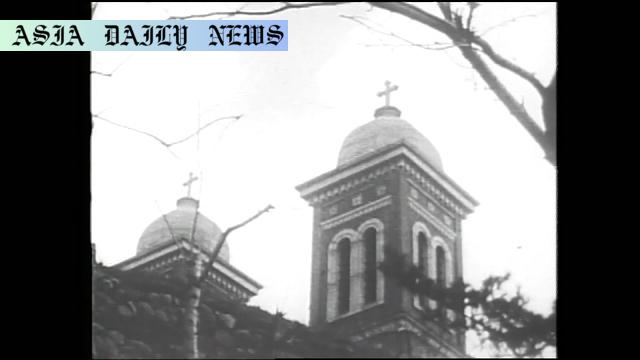Urakami Cathedral: A newly discovered video of Nagasaki’s iconic church, believed to be the oldest footage, has been unveiled by NHK.
Urakami Cathedral is featured in newly discovered footage from 1930.
The video is the oldest confirmed footage of the church before the atomic bombing.
NHK discovered the video in its archives, shot by kabuki actor Nakamura Shikaku.
Experts verified its date by studying postcards and Nakamura’s tour records.

Introduction to the Discovery of the Urakami Cathedral Video
The recent discovery of what is believed to be the oldest video footage of Nagasaki’s historic Urakami Cathedral has sparked excitement among historians and peace advocates alike. This rare video, preserved in NHK’s archives, unveils a 30-second glimpse into the past through the lens of kabuki actor and amateur filmmaker Nakamura Shikaku. The footage predates the cathedral’s destruction during the 1945 atomic bombing, offering an invaluable visual record of this iconic structure as it stood in its original form.
The Historical Significance of Urakami Cathedral
Urakami Cathedral, also known as the Cathedral of the Immaculate Conception, located in Nagasaki, Japan, holds immense historical value. Completed in 1925 after 30 years of meticulous construction, the cathedral was a symbol of resilience for Japanese Christians, who had faced persecution for centuries. The structure blended Neo-Romanesque architecture with local cultural influences, making it a standout landmark in Nagasaki. Tragically, it was devastated by the atomic bomb on August 9, 1945, which killed tens of thousands and obliterated much of the surrounding area. The current structure, rebuilt in the postwar period, serves as both a house of worship and a symbol of peace and reconciliation.
Details of the Discovered Video
The footage, approximately 30 seconds in length, was shot on a home movie camera by Nakamura Shikaku during a visit to Nagasaki in March 1930. The video provides a unique perspective, capturing the cathedral’s original features, including the white walls that were later repainted brick red in 1934. NHK collaborated with Matsuda Sei, head of the photo material research division at the Nagasaki Foundation for the Promotion of Peace, to analyze and verify the footage. By cross-referencing postcard imagery and Nakamura’s performance tour dates, experts confirmed the year as 1930, positioning this discovery as the earliest known video of the cathedral.
The Importance of Rediscovering Historical Media
The discovery of the Urakami Cathedral video underscores the critical role of archival research in uncovering lost pieces of history. As Matsuda noted, private videos often lack clear documentation, making them challenging to authenticate. However, when properly examined, they provide a visual bridge to the past, enriching our understanding of historical events and cultural heritage. In the case of Urakami Cathedral, this short video offers a poignant reminder of the lives and legacies affected by the atomic bomb and highlights the ongoing importance of preserving peace.
Preserving Historical Artifacts for Future Generations
While the modern world moves toward a digitally connected future, the preservation of historical artifacts such as photographs, videos, and written records remains a cornerstone of cultural continuity. This discovery raises awareness of the fragile nature of historical media and the need for institutions like NHK to maintain robust archival systems. For Nagasaki, this video is not only an artifact but a narrative thread that links the city’s past to its present efforts in promoting peace and remembrance. It serves as a symbol of the resilience of humanity in the face of destruction and a call to honor and learn from history.
Conclusion
The confirmation of the Urakami Cathedral video as the oldest footage to date brings renewed attention to the legacy of this historic structure and the events that shaped Nagasaki’s history. As historians and advocates continue to unearth and analyze such discoveries, they contribute to a richer, more nuanced understanding of the past. The rediscovered footage of Urakami Cathedral is a testament to the indomitable spirit of preservation and the profound impact of visual media in connecting generations across time.
Commentary
Reflection on the Discovery of the Urakami Cathedral Video
The rediscovery of the oldest known video footage of the Urakami Cathedral is deeply moving. As a symbol of Nagasaki’s rich heritage and its enduring spirit, this footage offers a rare glimpse into pre-war Japan. When we think of history, we often rely on the written word, but visual records like this video provide an emotional connection that transcends time. Seeing the cathedral in its original glory, before its tragic destruction, reminds us of the resilience of humanity and how we rebuild from loss and devastation.
The Emotional Weight of Historical Visual Media
What makes this discovery even more poignant is its context within Nagasaki’s tragic history. The cathedral was more than just a structure; it was a symbol of faith and perseverance for Japanese Christians. For it to be destroyed in an instant, along with so many lives, is an unimaginable tragedy. However, the rediscovery of this footage provides a unique way to honor those lost legacies. It is remarkable to think that this 30-second video, shot casually by an amateur filmmaker, now holds such profound historical significance.
The Importance of Archival Preservation
This discovery underscores the immense value of preserving historical artifacts. Archives, like NHK’s, serve as treasure troves of forgotten knowledge, waiting to be rediscovered. Each photograph, video, or document preserved has the potential to redefine how we view the past. The Urakami Cathedral video is a prime example of why we must invest in maintaining and digitizing such collections for future generations. Beyond its historical importance, the video is a poignant reminder of the destructive capabilities of war and the need for peace and global understanding.


